Arch of Constantine – The Arch of Constantine’s Architecture
The Arch of Constantine is a massive triumphal arch in Rome, but you may have a few questions about this monument to Constantine the Great. You may wonder to yourself: why was the Arch of Constantine built? When was the Arch of Constantine built? Who built the Arch of Constantine? What is the Arch of Constantine made of? What’s so special about the Arch of Constantine architecture? Or maybe you just want some extra Arch of Constantine facts. If this sounds intriguing, keep reading for some more Arch of Constantine facts!
A Look at the Arch of Constantine
| Architect | Unknown |
| Date Constructed | 315 CE |
| Function | Roman Triumphal Arch |
| Location | Via Triumphalis, Rome, Italy |
The Arch of Constantine is a 21 m tall monument dedicated to Emperor Constantine the Great that is located along the Via Triumphalis, which was the road in Ancient Rome that was used for celebratory processions after a great victory. The Arch of Constantine was built using existing monuments and later became part of the Frangipane fortress and fell into some level of disrepair before it was restored. Let’s take a closer look at when this monument was built, why it was built, what it was made of, who built it, and, lastly, a look at the architecture itself. You can keep reading for some more Arch of Constantine facts.
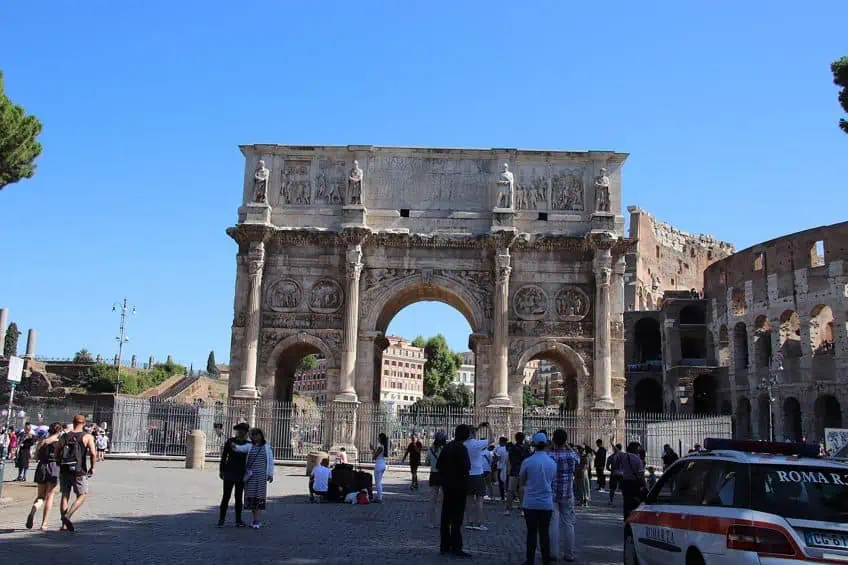
When Was the Arch of Constantine Built?
The Arch of Constantine was started in 312 but the construction of this monument was only completed in 315. This means that the Arch of Constantine was constructed, as the name might suggest, during the time of Constantine the Great, and it was built to commemorate his tenth year in power. Furthermore, that year happened to be the year of the decennalia festivities and games that were hosted as a massive celebration every ten years. This was probably a great coincidence that the Roman Senate took advantage of to appease Constantine before he seized complete power over Rome. The Arch of Titus and the Arch of Septimius are the only other two similar arches in Rome because The Arch of Constantine is one of only three surviving triumphal arches found there.
If you’ve ever wondered when the Arch of Constantine was built, look no further, but why was the Arch of Constantine built? Was it just because of the ten years of Constantine’s rule or was it something bigger than that?
Why Was the Arch of Constantine Built?
Why indeed. The Arch of Constantine was built because it certainly was a monument to ten years of Constantine’s rule, and the decennalia games happened to be taking place too, but more importantly, this monument was made to commemorate a great victory that led to the destruction of the Tetrarchy. Before this great victory, Rome was divided between four rulers, two senior and two junior, and Constantine was one of those senior Emperors in this four-person leadership system known as the Tetrarchy. He didn’t much appreciate that Emperor Maxentius held similarly large swaths of land, so on 28 October 312 CE, Constantine and Maxentius fought at the Battle of Milvian Bridge.
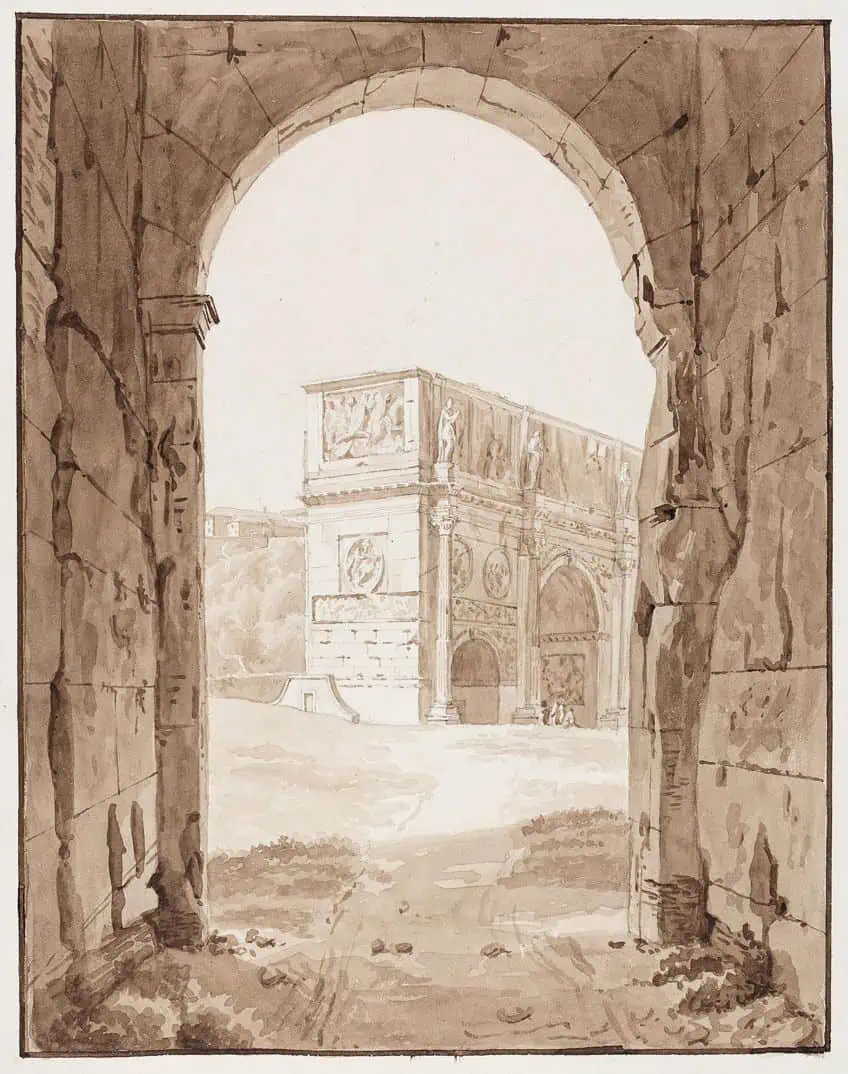
The battle came out in favour of Constantine, who was now likely well on his way to earning his moniker as Constantine the Great. This victory helped Constantine eventually become the singular ruler of Rome. This is the answer to that question: why was the Arch of Constantine built? Constantine seized more power than ever before and you do not want to be the Senate that refused him, do you? This is why the Arch of Constantine was built spanning the breadth of the Via Triumphalis, the road that was taken by Roman leaders whenever they returned after a victory. This triumphal arch was built between the Colosseum and Palatine Hill. This means that the Arch of Constantine is still visible today as a reminder of Constantine the Great, a man perhaps best known in the modern era for his integral role in early Christianity and for being the founder of Constantinople (or modern-day Istanbul).
The Arch of Constantine is a glorious monument to a ruler with a grandiose title, but what is the Arch of Constantine made of?
What Is the Arch of Constantine Made Of?
The Arch of Constantine is constructed of face-bricked concrete that has been covered in marble, as is quite traditional for Roman monuments of this description. The modern appearance of this triumphal arch is clean, white marble, and there tends to be a view that these ancient Roman monuments were created in white because the Romans understood the beauty and majesty of this clear and plain design. However, this is not the case.
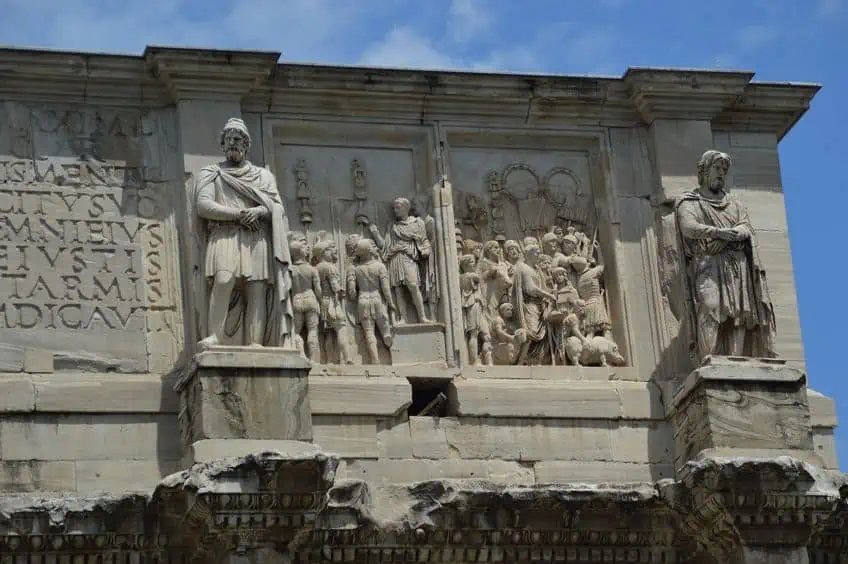
The Arch of Constantine, like many Roman monuments and statues, was covered in colourful ornamentation. The original design would have made use of vivid colours like a purple-red hue for the background, green on the main frieze and the statue pedestals, and purple for some of the statues. We cannot necessarily know the exact colours that would have been used, but the Arch of Constantine certainly wouldn’t have the ghostly white appearance it has today. The people who built the Arch of Constantine knew to outfit the monument in vivid colours, but who built the Arch of Constantine in the first place?
Who Built the Arch of Constantine?
The construction of the Arch of Constantine was ordered by the Roman Senate shortly after Constantine returned as the conquering hero from his victory over Maxentius. The Senate clearly took the hint from Constantine while he led his triumphal procession through Rome. The Senate even ensured that the inscription, which was on both sides of the arch to ensure that no one would ever miss it, stated this declaration at the very top of the arch in gilded bronze:
To the Emperor Caesar Flavius Constantinus, the greatest, pious, and blessed Augustus: because he, inspired by the divine, and by the greatness of his mind, has delivered the state from the tyrant and all of his followers at the same time, with his army and just force of arms, the Senate and People of Rome have dedicated this arch, decorated with triumphs.
The question of who built the Arch of Constantine is answered by this inscription. Who would want to ensure that the new sole leader of the Roman Empire was happy? Furthermore, the inscription directly calls Maxentius, who was one of the other leaders under the Tetrarchy, a tyrant. This reveals how the Arch of Constantine reveals a deep-seated need to produce political propaganda that could be displayed for all to see right beside the Colosseum, which is one of the (if not the most) famous structures in Rome.
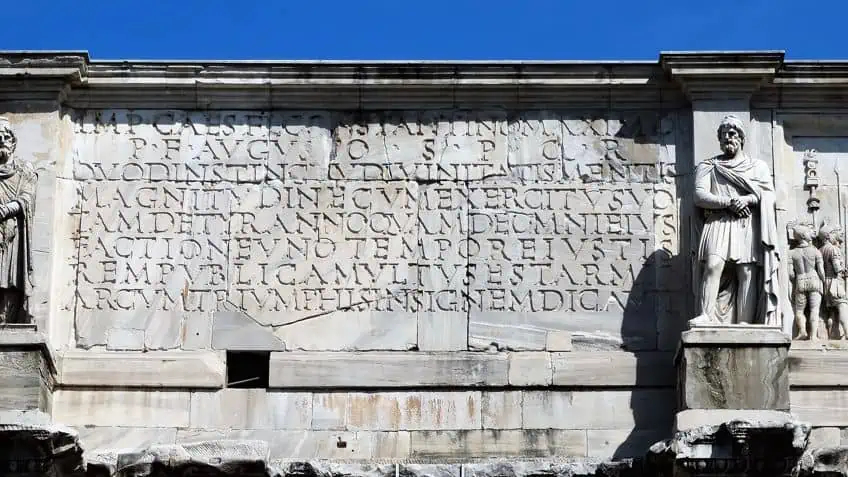
The Arch of Constantine did eventually become part of the Frangipane fortress in the Middle Ages and fell into some level of disrepair. It was eventually restored under the order of Pope Clement VIII in 1597 CE. This restoration did not alter the original iconography, so we can still see the Arch of Constantine architecture as it has always been, although using the term “original” may not be the best choice of words in this instance.
The Arch of Constantine Architecture
The Arch of Constantine is a massive triumphal arch that stands high above all onlookers. The arch is 21 m tall, 25.9 m wide, and 7.4 m deep. It makes use of a three-bay design with engaged Corinthian columns. The arch itself is inlaid with various marble panels that depict Constantine the Great both at war and doing the civic duties that would be expected of him. The most famous of these important events were the ones for which he specifically received this arch: his siege of Verona, his battle with Maxentius, his gift-giving ceremony, and his addressing of the people.
The Arch of Constantine architecture is clearly designed to very specifically call Constantine’s achievements to attention as best as possible, but upon closer inspection, the Arch of Constantine is a bit of a strange thing. This is why we cannot necessarily use the term “original” when talking about the architecture of this particular monument.
The Arch of Constantine may have been dedicated to Constantine the Great, but many of the sculpted sections were actually taken from existing reliefs and statues that were dedicated to other Roman emperors such as Trajan, Hadrian, and Marcus Aurelius. This has led to the Arch of Constantine being seen as a combination of various styles that were all thrown together, and this has even led some art historians to argue that this usage of existing monuments, along with its blocky, original sculptures, indicates the beginnings of the downfall of the Roman Empire. This view has been rejected by many contemporary art historians though.
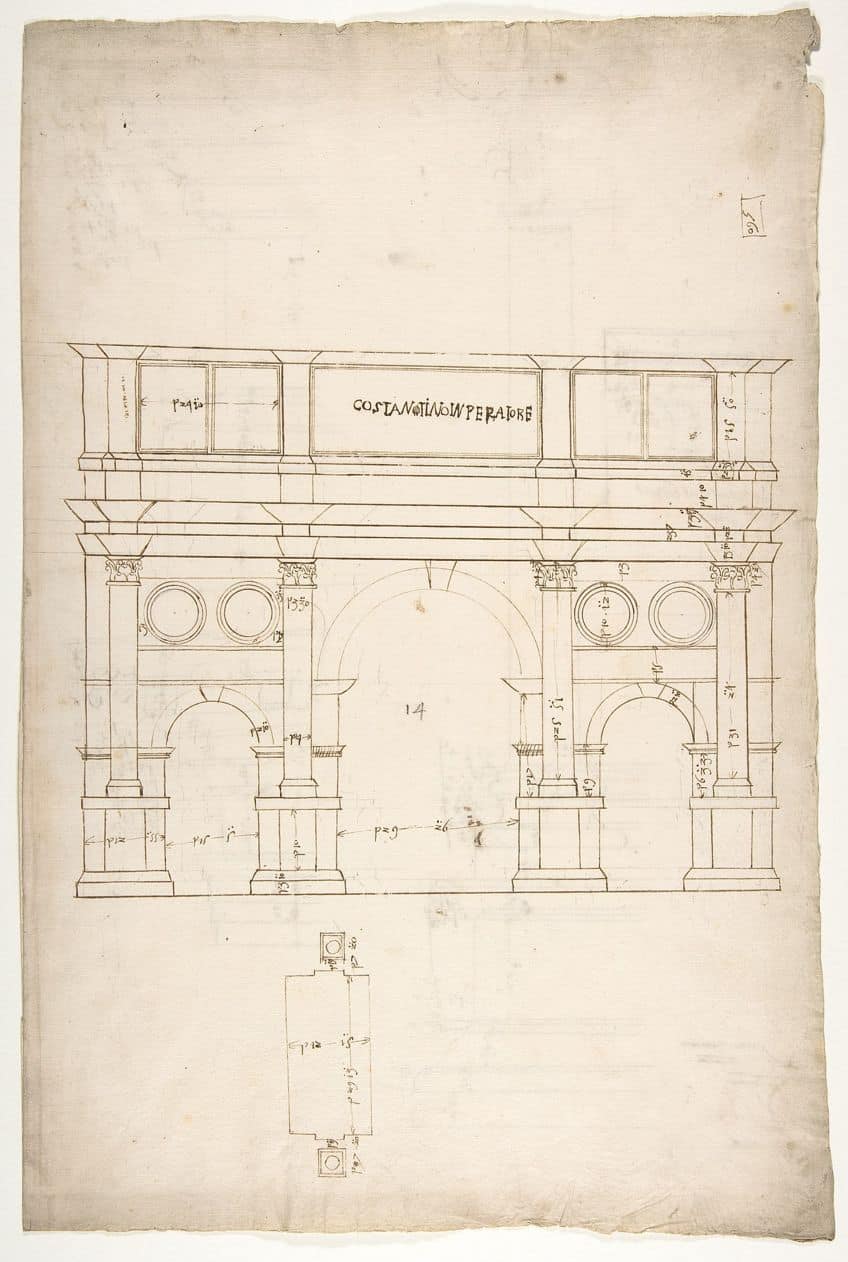
This does mean that the Arch of Constantine architecture is a bit of a difficult thing to discuss. It may have been dedicated to Constantine the Great, but was it even truly and fully made during his reign? Was it simply a reworked monument from Hadrian’s time or, as some suggest, was it constructed under the orders of Maxentius or even Domitian? We may never know the exact specifics, but what we do know is that the dedication on both sides of the Arch of Constantine very much calls attention to Constantine the Great above everyone else. Perhaps this does answer the previous question about who built the Arch of Constantine, but it simply leads to a new question: who really built the Arch of Constantine?
We’ll probably never be certain, but we can be certain that there are a few extra Arch of Constantine facts worth knowing now that we’ve discussed the history of this triumphal monument.
Some Extra Arch of Constantine Facts
Is there anything else that can be said about the Arch of Constantine? Have a look below for some extra Arch of Constantine facts:
- The Arch of Constantine is the largest such arch currently in Rome. The Arch of Titus and the Arch of Septimius are the others.
- The Arch of Constantine is the most represented and photographed of all the arches in Rome. Likely due to the monument being right beside the Colosseum. So, wouldn’t you take a picture too?
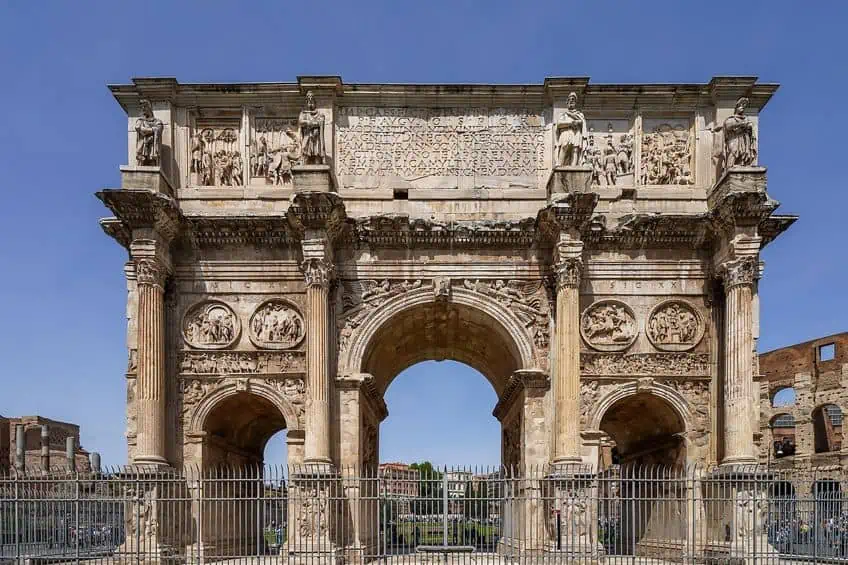 Arch of Constantine (Rome) – South side, from Via triumphalism (315 BCE); NikonZ7II, CC BY-SA 4.0, via Wikimedia Commons
Arch of Constantine (Rome) – South side, from Via triumphalism (315 BCE); NikonZ7II, CC BY-SA 4.0, via Wikimedia Commons
- The Arch of Constantine had new life in the 1960 Summer Olympics because it was used as a finish line for one of the marathon events. A little contemporary triumph for a triumphal arch.
- The Arch of Constantine inspired other arches around the world like the Marble Arch in London, the Siegestor in Munich, and the Arcade du Cinquantenaire in Brussels.
- The Arch of Constantine can be visited right now. There is a fence that stops anyone from getting too close, but you can get close enough to see the gorgeous architecture up close and personal.
The Arch of Constantine started its life as a Roman triumphal arch to commemorate Constantine the Great, but it eventually became part of an unrelated fortress and now stands as a tourist destination. However, its legacy has lived on as an influence to other arches.
Frequently Asked Questions
Why Was the Arch of Constantine Built?
The Arch of Constantine was built to commemorate Constantine the Great’s victory over Maxentius, and it was constructed between 312 CE and 315 CE.
What Is the Arch of Constantine Made Of?
The Arch of Constantine was made of concrete bricks covered in marble. The arch was inlaid with various gorgeous sculptures.
Who Built the Arch of Constantine?
It was commissioned by the Roman Senate for Constantine the Great. However, the architect is unknown.
What About the Arch of Constantine Architecture?
The Arch of Constantine architecture was comprised of various reliefs and sculptures that were taken from other monuments, that had been created before Constantine’s rule.
Justin van Huyssteen is a writer, academic, and educator from Cape Town, South Africa. He holds a master’s degree in Theory of Literature. His primary focus in this field is the analysis of artistic objects through a number of theoretical lenses. His predominant theoretical areas of interest include narratology and critical theory in general, with a particular focus on animal studies. Other than academia, he is a novelist, game reviewer, and freelance writer. Justin’s preferred architectural movements include the more modern and postmodern types of architecture, such as Bauhaus, Art Nouveau, Art Deco, Brutalist, and Futurist varieties like sustainable architecture. Justin is working for artfilemagazine as an author and content writer since 2022. He is responsible for all blog posts about architecture.
Learn more about Justin van Huyssteen and about us.
Cite this Article
Justin, van Huyssteen, “Arch of Constantine – The Arch of Constantine’s Architecture.” artfilemagazine – Your Online Art Source. March 16, 2023. URL: https://artfilemagazine.com/arch-of-constantine/
van Huyssteen, J. (2023, 16 March). Arch of Constantine – The Arch of Constantine’s Architecture. artfilemagazine – Your Online Art Source. https://artfilemagazine.com/arch-of-constantine/
van Huyssteen, Justin. “Arch of Constantine – The Arch of Constantine’s Architecture.” artfilemagazine – Your Online Art Source, March 16, 2023. https://artfilemagazine.com/arch-of-constantine/.


